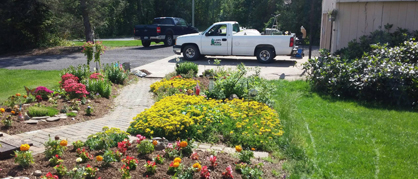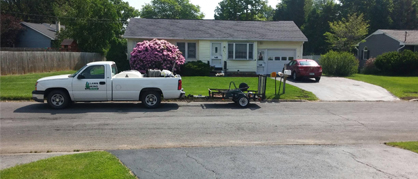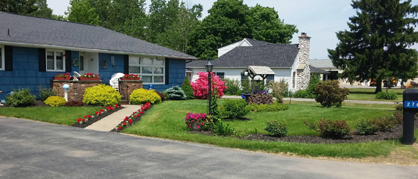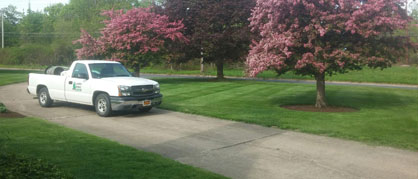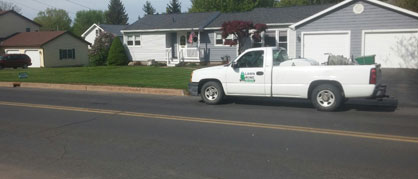
Applications
Destructive Turfgrass Insects
A lush, dark green stand of Turfgrass is one of the favorite foods of many insects,Turfgrass insects can be divided into two groups. One is that group which feeds on plant parts above ground and the other on grass roots and rhizomes.
Above Ground Turf Insects
SOD WEBWORM (Crambusspp,)
Sod webworm larvae live in tunnels located in the thatch layer and feed by chewing on turf leaf blades and stems at night. The small brown worms are 3/4" long and have dark spots scattered along their back. There are 2-3 life cycles in this area which last about 6 weeks each.The adult is a light brown moth, which flutters over the turf laying eggs during the summer months. The application of an insecticide 10-14 days after peak moth activity will give the best control against sod webworm larvae.
CHINCHBUG (Blissus spp.)
Adults favor hot, dry sunny turfgrass areas. Populations of 200 or more per square foot are not uncommon in heavily infested areas. The chinchbug insect salivary fluids into the leaf tissues and sucks out the contents of the cells. The turf wilts and quickly turns brown,Chinchbugs only reach 1/5" long as adults. They are black with white wings folded over their back. One to two generations per year are common for this area. The best time to manage chinchbugs is in the spring as the overwintering adults become active.
GREENBUG APHID (SchizaphisgraminumRonaldi)
The greenbug is a relatively new turf pest. However it has been a pest of small grains and sorghum for some time. It is a soft-bodied insect 1/16" long, light green with a stripe down its back. Similar to the chinchbug, salivary fluids are injected into the plant and the contents sucked out by the aphid. They feed from June until the weather turns cold.Infestations commonly occur beneath shade trees. However, entire lawns can become infested. The turf sometimes turns a yellow-orange color before becoming brown. Twenty to thirty aphids can feed on a single leaf blade. Insecticides can be used to manage the greenbug, but some insecticide resistance has been reported.
CUTWORMS AND ARMYWORMS (Many Species)
Both of these pests are the larvae of night-flying moths two to three times the size of sod webworms. They live in the thatch layer and feed at night by chewing the grass plant. Both may appear similar, but the armyworm has a white inverted "Y" marking on the front of its head.There are one to three generations per year, They can feed from late April through the fall. Birds have a keen ability to detect these worms and cause numerous small round holes in the turf when feeding on them. The application of an insecticide while the worms are feeding usually will control them.
Below Ground Insects
WHITE GRUBS
Grubs are the larvae of many beetle species, including Japanese, masked chafer, May or June beetle and European chafer. The adult beetles lay eggs in the Turfgrass in July and August. They hatch and feed on the grass roots until cold weather sets in. The grubs overwinter 3 to 12 inches below ground and once again feed on the roots when spring weather arrives. Most grubs will pupate in the May-June period and emerge as beetles.
Larvae are 1/2" - 3/4" long, except June beetle grubs which can grow to over 2". They are "C" shaped and are the favorite food of skunks, racoons and moles. By eliminating the grubs from the grass roots with an insecticide, other animal problems will also disappear. Milky spore, a bacteriawhich can be applied to the soil, is a biological control of Japanese beetle grubs which is widely used.
BLACK TURFGRASS ATAENIUS (Ataeniusspretulus and Aphodiusgranarius)
The grubs of the Ataenius beetle are C shaped and only 3/8" long but are very destructive. Damaged Turfgrass areas appear to be under heat stress. However, upon closer inspection, high populations of this small grub can destroy Turfgrass roots.
The adult, a small black beetle, overwinters 1-2 inches below the soil surface in wooded areas under debris. They emerge in March-May and burrow into the turfgrass. Eggs are deposited in the soil and hatch from late May to mid-July. They feed on roots, pupate and emerge as adults in early August. A second generation then occurs. Insecticides effective against other white grubs will manage the Ataenius larvae.
BILLBUGS (Many Species)
The Phoenix billbug on Bermuda, the hunting billbug on zoysia and the bluegrass billbug all seriously damage Turfgrass. A member of the weevil family, the larvae are legless and 3/8" long. They feed on turf roots and stems.
The adults are characterized by their long snouts and overwinter in both lawn and wooded areas. They can be seen wandering as soon as it warms up in the spring. This is the best time to manage billbugs. During April-June, the adults chew holes in grass stems and lay eggs, which hatch in two weeks. The larvae then start feeding down the stem to the roots and thizomes. They pupate in August and emerge as adults to' overwinter once again in protected areas.
Lawn King
18 Cole Road
Fulton, NY 13069
(315) 678-2992
(315) 591-0540 - cell
lawnking1958@aol.com


